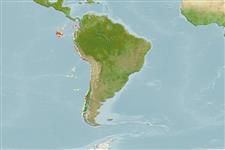Holocephali (quimeras) (chimaeras) >
Chimaeriformes (Chimaeras) >
Chimaeridae (Shortnose chimaeras or ratfishes)
Etymology: Hydrolagus: hydro-, combining form of hydor (Gr.), water; lagos (Gr.), hare, i.e., “water rabbit,” probably referring to three pairs of tooth plates, which tend to protrude from the mouth like a rabbit’s incisors. (See ETYFish); alphus: Greek for a white spot on the skin, referring to noticeable white spot on sides. (See ETYFish).
Environment: milieu / climate zone / depth range / distribution range
Ecologia
marinhas batidemersal; intervalo de profundidade 600 - 900 m (Ref. 57721). Tropical
Distribuição
Países | Áreas da FAO | Ecossistemas | Ocorrências | Point map | Introduções | Faunafri
Eastern Central Pacific: Galapagos Islands.
Tamanho / Peso / Idade
Maturity: Lm ? range ? - ? cm
Max length : 41.9 cm TL macho/indeterminado; (Ref. 57721); 48.0 cm TL (female)
Descrição suscinta
Morfologia | Morfometria
Assigned to the genus Hydrolagus based upon the absence of an anal fin. Hydrolagus alphus is distinguished by being medium in size (average PCL 321 mm) and uniform dark brown in color with a distinct white spot (4%-6% BDL) on the lateral side above the pectoral fins. Paired fins with bluish hue and white margins. The dorsal spine longer than triangular shaped first dorsal fin and extends beyond the origin of the second dorsal fin when depressed. Eyes large (40.8–44.5% HDL) and pectoral fins reaching to or beyond insertion of pelvic fins when depressed. Pelvic claspers small, not extending beyond distal edge of pelvic fin, and divided distally for one half their length with slender fleshy denticulate tips. The base of second dorsal fin is long, deeply depressed and light colored in the center, anterior and posterior regions dark, considerably greater in height than the white middle region (Ref. 57721).
Ciclo de vida ou comportamento de acasalamento
Maturidade | Reprodução | Desova | Ovos | Fecundidade | Larvas
Quaranta, K.L., D.A. Didier, D.J. Long and D.A. Ebert, 2006. A new species of chimaeroid, Hydrolagus alphus sp. nov.(Chimaeriformes: Chimaeridae) from the Galapagos Islands. Zootaxa 1377:33-45. (Ref. 57721)
Status na Lista Vermelha da UICN (Ref. 130435)
Ameaça para os humanos
Harmless
Uso pelos humanos
Mais informação
PaísesÁreas da FAOEcossistemasOcorrênciasIntroduçõesEstoquesEcologiaDietaItens alimentaresConsumo alimentarRação
Nomes comunsSinônimosMetabolismoPredadoresEcotoxicologiaReproduçãoMaturidadeDesovaAgregação de desovaFecundidadeOvosDesenvolvimento dos ovos
Idade/TamanhoCrescimentoPeso-comprimentoComprimento-comprimentoFrequências de comprimentoMorfometriaMorfologiaLarvasDinâmica larvalRecrutamentoAbundânciaBRUVS
ReferênciasAquaculturaPerfil para aquaculturaEstirpesGenéticaElectrophoresesHereditariedadeDoençasProcessamentoNutrientsConversão de massa
ColaboradoresFotosStamps, Coins Misc.SonsCiguateraVelocidadeTipo de nataçãoÁrea branquialOtólitosCérebrosVisão
Ferramentas
Relatórios especiais
Baixar XML
Fontes da internet
Estimates based on models
Preferred temperature (Ref.
123201): 3.7 - 7, mean 5.7 °C (based on 7 cells).
Índice de diversidade filogenética (Ref.
82804): PD
50 = 0.5000 [Uniqueness, from 0.5 = low to 2.0 = high].
Bayesian length-weight: a=0.00282 (0.00118 - 0.00673), b=3.10 (2.89 - 3.31), in cm total length, based on LWR estimates for this (Sub)family-body shape (Ref.
93245).
Nível Trófico (Ref.
69278): 3.7 ±0.6 se; based on size and trophs of closest relatives
Resiliência (Ref.
120179): Baixo, tempo mínimo de duplicação da população 4,5 - 14 anos (Deep-water species, few large eggs.).
Fishing Vulnerability (Ref.
59153): Moderate vulnerability (38 of 100).
